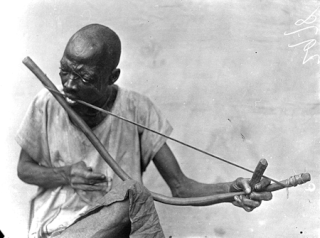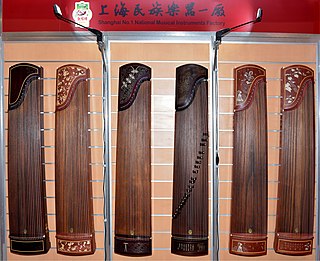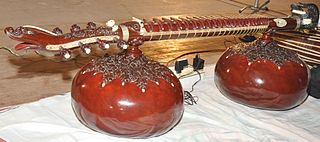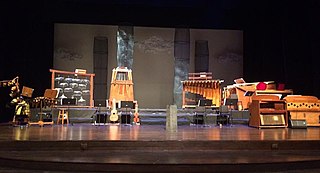
The musical bow is a simple string instrument used by a number of South African peoples, which is also found in the Americas via slave trade. It consists of a flexible, usually wooden, stick 1.5 to 10 feet long, and strung end to end with a taut cord, usually metal. It can be played with the hands or a wooden stick or branch. It is uncertain if the musical bow developed from the hunting bow, though the San or Bushmen people of the Kalahari Desert do convert their hunting bows to musical use.

The dholak is a two-headed hand drum, a folk percussion instrument. The instrument is about 45 cm in length and 27 cm in breadth and is widely used in qawwali, kirtan, lavani and bhangra. The drum has two different sized drumheads. The smaller drumhead is made of goat skin for sharp notes while the bigger drumhead is made of buffalo skin for low pitch. The two drumheads allow a combination of bass and treble with rhythmic high and low pitches. The body or shell of the Dholak is made of sheesham or mango wood. The larger membrane, played with a stick, has a compound (Syahi) applied which helps to lower the pitch and produce the sound. The smaller drumhead is played with the left hand which produces a high pitch. A cotton rope lacing and screw-turnbuckle are used to release tension while playing. Steel rings/pegs are twisted inside the laces to attain fine tuning. Dholak can be played in three ways — on the player’s lap, while standing, or pressed down with one knee while sitting on the floor.

The trapezoidal yangqin is a Chinese hammered dulcimer, likely derived from the Iranian santur or the European dulcimer. It used to be written with the characters 洋琴, but over time the first character changed to 揚, which means "acclaimed". It is also spelled yang quin or yang ch'in. Hammered dulcimers of various types are now very popular not only in China, but also Eastern Europe, the Middle East, India, Iran, and Pakistan. The instruments are also sometimes known by the names "santoor" and "cymbalom". This instrument had an influence on the Thai classical instrument, known as Khim (ขิม).

The đàn bầu
The Garland handbook of Southeast Asian music 2008 Page 261 "The đàn bầu is played solo or to accompany folk songs, tales, and epics. It has had a remarkable history. Discriminated against at times, it has been an instrument of blind street beggars, yet it was also an instrument of choice at the Tran imperial court (1225-1400)."</ref>

The guqin is a plucked seven-string Chinese musical instrument. It has been played since ancient times, and has traditionally been favoured by scholars and literati as an instrument of great subtlety and refinement, as highlighted by the quote "a gentleman does not part with his qin or se without good reason," as well as being associated with the ancient Chinese philosopher Confucius. It is sometimes referred to by the Chinese as "the father of Chinese music" or "the instrument of the sages". The guqin is not to be confused with the guzheng, another Chinese long stringed instrument also without frets, but with moveable bridges under each string.

The zheng or guzheng, is a Chinese plucked zither. The modern guzheng commonly has 21, 25, or 26 strings, is 64 inches long, and is tuned in a major pentatonic scale. It has a large, resonant soundboard made from Paulownia wood. Other components are often made from other woods for structural or decorative reasons. Guzheng players often wear fingerpicks made from materials such as plastic, resin, tortoiseshell, or ivory on one or both hands.

Ektara is a one-stringed musical instrument used in the traditional music of South Asia, and used in modern-day music of Bangladesh, India, and Pakistan.

The Rudra veena —also called Bīn in North India—is a large plucked string instrument used in Hindustani classical music, especially dhrupad. It is one of the major types of veena played in Indian classical music, notable for its deep bass resonance.
In music, intonation is the pitch accuracy of a musician or musical instrument. Intonation may be flat, sharp, or both, successively or simultaneously.

The tro is Cambodia's traditional spike fiddles, bowed string instruments that are held and played vertically. Spike fiddles have a handle that passes through the resonator, often forming a spike, on the bottom side where it emerges. The family is similar or distantly related to the Chinese erhu or huqin. The instruments have a soundbox at the bottom of the stick, covered with leather or snake skin. Strings run from pegs at the top of the stick and secured at the bottom, running across the soundbox. The larger the soundbox, the lower the pitch range. Instruments in this family include the two-stringed tro ou, tro sau thom, tro sau toch and tro che, as well as the three-stringed tro Khmer spike fiddle. The two-stringed tros are tuned in a fifth, while the three-stringed tro Khmer is tuned in fourths. The tros, with the exception of the tro Khmer, are strung so that the bowstring is permanently placed between the two stings. When the musician plays, the placement of the bow causes the strings to be played at once, one from below and one from above. In contrast, western fiddles are played with the bow pushing on each string from the outside, as is also the case with the tro khmer.

Tinikling is a traditional Philippine folk dance which originated during the Spanish colonial era. The dance involves at least two people beating, tapping, and sliding bamboo poles on the ground and against each other in coordination with one or more dancers who step over and in between the poles in a dance. It is traditionally danced to rondalla music, a sort of serenade played by an ensemble of stringed instruments which originated in Spain during the Middle Ages. The locomotor movements used in tinikling are hopping, jumping, and turning.

Traditional Korean musical instruments comprise a wide range of string, wind, and percussion instruments. Many traditional Korean musical instruments derive from Chinese musical instruments.
Traditional Vietnamese musical instruments are the musical instruments used in the traditional and classical musics of Vietnam. They comprise a wide range of string, wind, and percussion instruments, used by both the Viet majority as well as the nation's ethnic minorities.
Bamboo is a settlement in The Saint Ann Parish, Jamaica. Its population as of a 1991 census was 3,732 inhabitants.

Bamboo's natural hollow form makes it an obvious choice for many musical instruments.
An idiochord is a musical instrument in which the "string" of the instrument is made from the same material as its resonating body. Such instruments may be found in the Indian Ocean region, disparate regions of Africa and its diaspora, and parts of Europe and North America.

The American composer Harry Partch (1901-1974) composed using scales of unequal intervals in just intonation, derived from the natural Harmonic series; these scales allowed for more tones of smaller intervals than in the standard Western tuning, which uses twelve equal intervals. One of Partch's scales has 43 tones to the octave. To play this music, he built many unique instruments, with names such as the Chromelodeon, the Quadrangularis Reversum, and the Zymo-Xyl.

The tube zither is a stringed musical instrument in which a tube functions both as an instrument's neck and its soundbox. As the neck, it holds strings taut and allows them to vibrate. As a soundbox or it modifies the sound and transfers it to the open air. The instruments are among the oldest of chordophones, being "a very early stage" in the development of chordophones, and predate some of the oldest chordophones, such as the Chinese Se, zithers built on a tube split in half. Most tube zithers are made of bamboo, played today in Madagascar, India, Southeast Asia and Taiwan. Tube zithers made from other materials have been found in Europe and the United States, made from materials such as cornstalks and cactus.
The Yalamber or Yahamber Baja is a Nepali tube zither in the Kirati tradition. It is one of three tube-zithers documented in Nepal by the Nepali Folk Musical Instruments Museum in 2004.

The eka-tantrī vīṇā was a medieval tube-zither veena in India, with a single string and one or more gourd resonators. The instrument became prominent in Indian music in about the 10th century C.E. as instruments of court music. Alongside the alapini vina and kinnari vina it replaced the harp-style veenas and lute-style veenas in sculpture. It was possibly a forerunner of the rudra vina. It shares its name with the modern single-string drone lute, the ektara.














